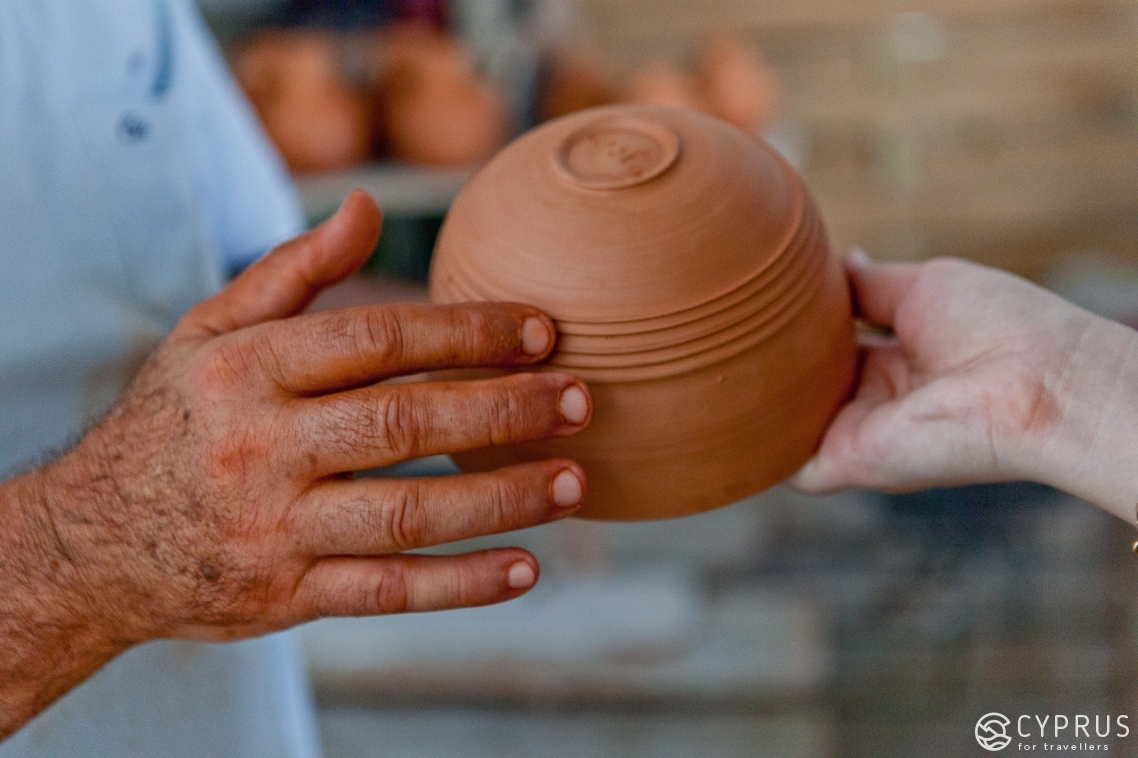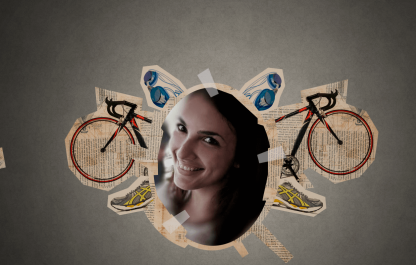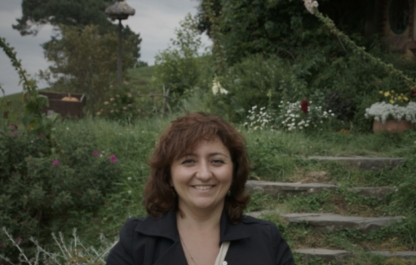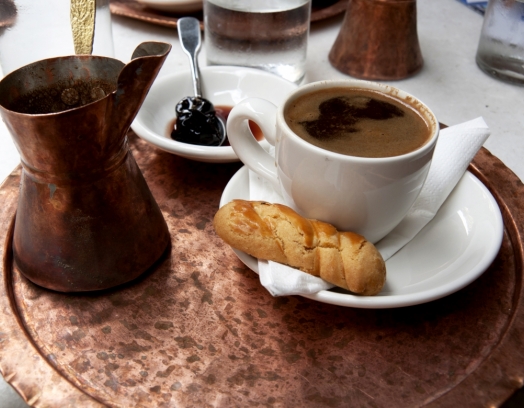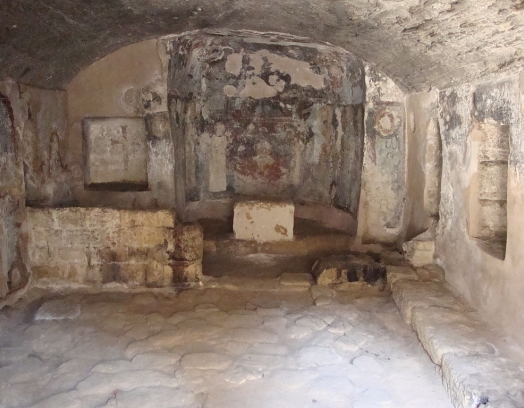If you ever visit Old Paphos you’ll probably hear about or come across a place beloved both by the locals and the foreigners. It is called just that: «The Place».
We’ve written about it before. Now thanks to the invitation from its founder and director Natalia Hadjigeorgiou we have a chance to meets its artisans and learn more about the local crafts and its secrets. We also look forward to experiencing the centuries-old traditions, knowledge and wisdom that these artisans carry on from their ancestors.
Costas: I was born in Famagusta [where Varosha neighborhood was once known for producing and exporting the famous varosha ceramics. The basic material used was soft yellow clay and the pattern contained anthropomorphic and zoomorphic figures and elements. – ed.], which is now part of the occupied territories. I finished vocational school where I studied pottery making. It took me three years to complete my studies.
Shortly because of the war in 1974 we had to flee the area and became refugees. This is how I ended up in Paphos, where I opened my own studio. I was able to support myself through my craft for the following 12 years. Then I realized that I was tired of it and decided to try something new. My wife (who is a chef) and I opened a restaurant, which existed for another 10 years. Then we both started working at a small hotel that’s part of the Tsokkos Hotels & Resorts Cyprus, where I was the maître d’hôtel.
Right now I am about to retire and would like to go back to my work, or really my hobby, that I once left behind. I’ve had enough of the hotel/restaurant business.
There is no pressure: I come to ThePlace and spend time with groups of students from all of Cyprus as well tourists. Many children (Greek, Cypriot, Russian, British, American) choose pottery because of the texture of the clay and the seeming simplicity of this craft [Costas smiles]. But we know that to make such a seemingly plain pot, you need a lot of experience and practice!
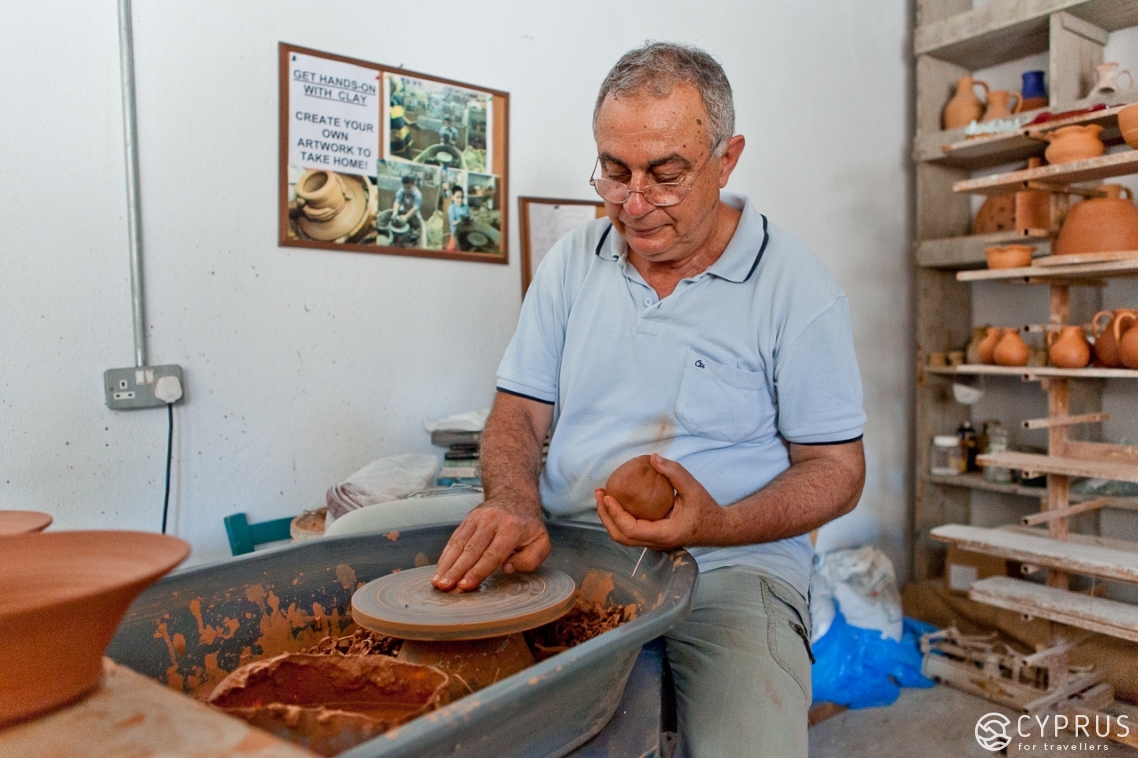
I should say that about 90% of the people, who come here get a good first result. We then usually fire the clay and then a week later it’s ready to be picked up.
I’ve also noticed that pottery is becoming very popular among older Cypriots. There are also those who try to stay away from pottery (don’t laugh). These are mostly women with a nice manicure. I think that’s one of the reasons why there are so few women in this industry.
The art of pottery making is more complicated than simply putting a slab on the wheel. You need to practice. Plus, there are types of ceramics that can be created without a pottery wheel – those are actually quite easy to make.
— So you are saying that the majority of your students are boys?
— Actually, no. Girls are more interested in pottery. They are more hardworking and focused. Their hands are more sensitive to detail and understand the pottery wheel better. However, boys are stronger, which is also an important factor when it comes to working with the wheel.
— Many people believe that larger pottery items are made by men, whereas the smaller ones are created by women.
— You might be surprised, but in Cyprus the largest pots, pitchers and other items that were made «in circles», one step at a time come from the village of Foini and Cornos and were created by women. Pottery wheel have usually been the men’s prerogative.
Costas’ own works, which you can find in the studio, were made using red clay. He likes to fire and glaze them using mostly shades of blue and green. They have a classical shape and an elongated bottom part.
— As a native of Famagusta – a region that is known for its ceramics – did you bring anything from that tradition into your Paphos work? Does your current work reflect the influence of your hometown and how does Paphos «manifest» itself in your craft?
— My connection to my hometown is evident in the shape of my pottery items. You see, you can’t escape your roots, your traditions. It’s part of us by default. Paphos too has been able to find a place in my work. At the same time, I also like to steer away from traditions and experiment. I like to play around with the glaze and its colors!
You want to know a secret? I don’t use factory-made dyes, only the ones I made myself.
— Are your students privy to all the secrets of your work?
— Of course not! [laughs]. I teach them the foundation of pottery making, all the basic steps: how to work with the clay, how to glaze and fire it. The rest – is the result of their own experiments and effort, which are essential in this type of work. The easiest thing to do is to buy all the foreign «ingredients», which happen to be quite expensive. This is why I think most potters like to find their own direction by perfecting their craft and reaching new heights. Why not? And when we do come up with our own shade or color, it becomes our own secret and achievement.
I remember my teacher in pottery school used to say, «It’s a shame not to experiment. When you do everything automatically, you are making the same thing and wasting your time!»
So I think that all the mishaps that happen when you learn something new – are part of your unique experience and that only work to your benefit.
— How many of your students go on to pursue pottery making on a professional level?
— Not many, maybe two or three for every one thousand students.
Plus, it’s become difficult to be a craftsman in Cyprus. A lot of things are now being imported, especially from China. And it’s much cheaper to purchase those items in bulk than buy them from independent artisans, despite the fact that handmade items are far better in quality.
Twenty-thirty years ago craftsmen had a great life here in Cyprus. They made good money. Now many of the studios have closed, especially large ones. You can still find independent craftsmen like myself. We try to treat pottery making as art, and all the works we create are one of a kind. It’s not a bad thing, but it might not help to keep pottery traditions alive. Do you know why that is? In today’s world it’s no longer required that you become a great craftsman. All you need is imagination and some experience working with a given medium.
A lot of the young people are into this type of «art».
— Still, what does one need to know and buy, if he/she wants to learn your craft and master clay on his/her own?
— Besides learning to master small pottery wheels (both mechanical and electric ones), you might want to first try working with self-drying polymer clay of different colors. In this case, however, you will be limited to making only decorative items and not practical ones.
A serious potter needs a good kiln, which is quite an investment.
— I see. Now what type of pottery is the most popular among buyers? What is the difference between what is popular among foreigners and what is popular among Cypriots?
— Everyone likes clay milk jars and pomegranates (which symbolize luck in Cyprus).
Now I am going to show you how it all comes together.

The craftsman sits in front of the wheel and throws a small lump of clay using lightly moistened hands. Then Costas takes a large lump of clay, rolls it into a round shape and puts some water over it. He then places it on top of the wheel by lightly tapping on it with his fist.
Costas: you have to push the clay towards the center of the circle; otherwise the clay will simply fly in different directions.
Then use your thumb to make an opening, which will allow your shapeless lump of clay to gradually grow into something more.

Your hands have to stay fixed in one position: your left hand is supposed to be inside and your right hand is supposed to be outside the vessel. Both of them have to slowly move upwards from the bottom of the vessel to the top. Your hands have to work in sync, using the same pressure to make sure the walls of the vessel are the same in thickness.
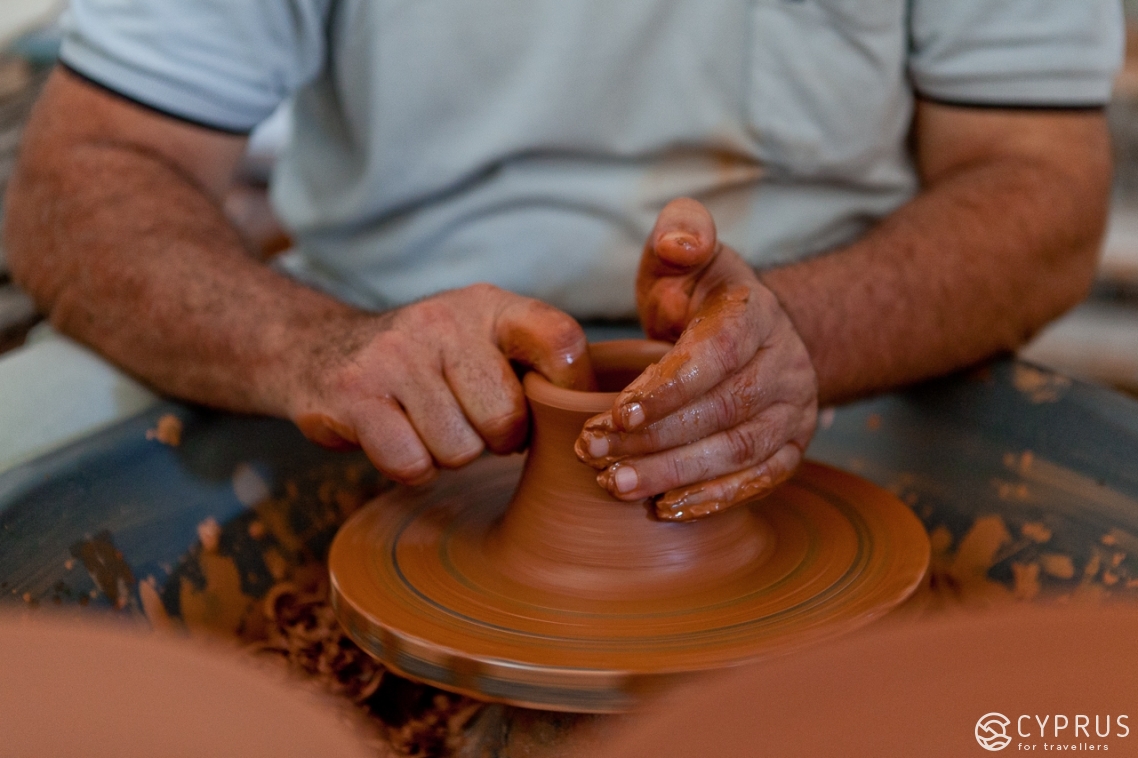
Costas says that the main principle is the following: push and pull up. You have to be very careful, because the clay is very soft and malleable.
The molding process happens from the bottom up, and not the other way around. You finish the process by separating the vessel from the wheel using a thin wire.
Molding the clay is just the first step in pottery making. A few hours later when the clay dries up a little (Costas says it will resemble the texture of leather by that point), we will start decorating it (we can carve out a relief or make additional openings). On the next day, we can attach handles or other decorative elements.
I like to really develop my work and focus on the details. This one, for example, (Costas picks up something from his shelf) was made this morning.
It’s noon right now and you can see that the texture of the surface has become smooth and soft like leather. It’s time for the next step: I turn it upside down, spin the pottery wheel and make the final touches, namely I slightly alter the bottom by making it longer. When I glaze the vessel later one, this part of the surface will remain rough to reveal the foundation.
I like natural clay for the feeling I get when working with it, for the opportunity to create something new that it gives me.
We thank Mr. Hadjigeorgiou for the incredible journey into the world of pottery and for the time we spent in his studio at ThePlace.
The next time you visit Paphos, make sure to check out this great studio located at:
Address: 56, Constantinou Kanari, Paphos
Telephone: +357 26101955, +357 99527717
Website: www.theplacecyprus.com
Email: theplace@theplacecyprus.com
Meanwhile, more fascinating encounters and journeys are soon to come!
See you!
Written by: Evgeniya Kondakova-Theodorou.
